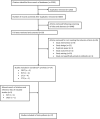A systematic literature review and meta-analysis of community pharmacist-led interventions to optimise the use of antibiotics
- PMID: 35112381
- PMCID: PMC9313811
- DOI: 10.1111/bcp.15254
A systematic literature review and meta-analysis of community pharmacist-led interventions to optimise the use of antibiotics
Abstract
Aims: The aim of this systematic review is to assess the effects of community pharmacist-led interventions to optimise the use of antibiotics and identify which interventions are most effective.
Methods: This review was conducted according to the PRISMA guidelines (PROSPERO: CRD42020188552). PubMed, EMBASE and the Cochrane Central Register of Controlled Trials were searched for (randomised) controlled trials. Included interventions were required to target antibiotic use, be set in the community pharmacy context, and be pharmacist-led. Primary outcomes were quality of antibiotic supply and adverse effects while secondary outcomes included patient-reported outcomes. Risk of bias was assessed using the 'Cochrane suggested risk of bias criteria' and narrative synthesis of primary outcomes conducted.
Results: Seventeen studies were included covering in total 3822 patients (mean age 45.6 years, 61.9% female). Most studies used educational interventions. Three studies reported on primary outcomes, 12 on secondary outcomes and two on both. Three studies reported improvements in quality of dispensing, interventions led to more intensive symptom assessment (up to 30% more advice given) and a reduction of over-the-counter supply up to 53%. Three studies led to higher consumer satisfaction, effects on adherence from nine studies were mixed (risk difference 0.04 [-0.02, 0.10]). All studies had unclear or high risks of bias across at least one domain, with large heterogeneity between studies.
Conclusions: Our review suggests some positive results from pharmacist-led interventions, but the interventions do not seem sufficiently effective as currently implemented. This review should be interpreted as exploratory research, as more high-quality research is needed.
Keywords: adherence; antibiotics; drug utilisation; quality use of medicines.
© 2022 The Authors. British Journal of Clinical Pharmacology published by John Wiley & Sons Ltd on behalf of British Pharmacological Society.
Conflict of interest statement
L.v.D. has received funding from Teva Pharmaceutical Industries for a study not related to this review. C.L. has received research grants from Abbott Diagnostics, unrelated to this review. No other funding was received for writing this review.
Figures


References
-
- Paget J, Lescure D, Versporten A, et al. Antimicrobial resistance and causes of non‐prudent use of antibiotics in human medicine in the EU. Publications Office of the European Union. 2017. doi:10.2875/326847 - DOI
-
- European Centre for Disease Prevention and Control . Antimicrobial Consumption in the EU and EEA: Annual Epidemiological Report 2019. 2019.
-
- McDonagh M, Peterson K, Winthrop K, et al. AHRQ Comparative Effectiveness Review No. 163: Improving antibiotic prescribing for uncomplicated acute respiratory tract infections. Agency for Healthcare Research and Quality; 2016. - PubMed
-
- Ranji SR, Steinman MA, Shojania KG, et al. Interventions to reduce unnecessary antibiotic prescribing: a systematic review and quantitative analysis. Med Care. 2008;46:847‐862. - PubMed
-
- Steinman MA, Ranji SR, Shojania KG, et al. Improving antibiotic selection: a systematic review and quantitative analysis of quality improvement strategies. Med Care. 2006;44:617‐628. - PubMed
Publication types
MeSH terms
Substances
LinkOut - more resources
Full Text Sources
Medical

